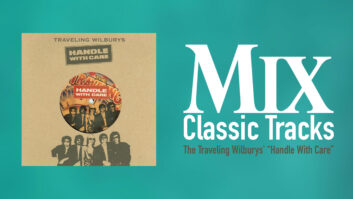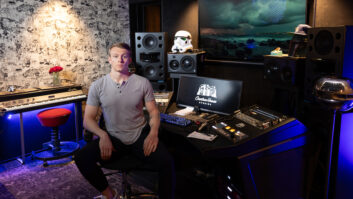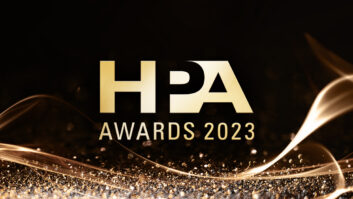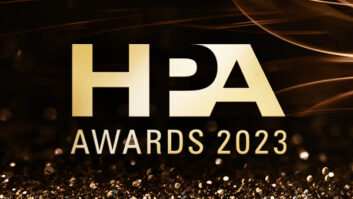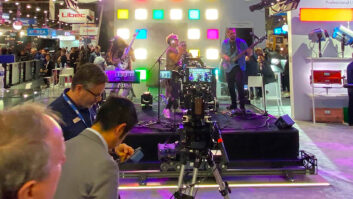photo: Invasion Still Courtesy ABC
For decades, scoring music for television has simply involved a scaled-down version of the art and process used on theatrical features: orchestral music cues hitting their marks and then moving on to the next, all at a fairly rapid production clip. While the schedule hasn’t changed too much, the tools available to composers have. Many television composers can now roll out of bed, grab a cup of coffee and head into a bedroom studio, turn on their G5 and Tascam GigaStudio and create the same atmosphere that used to require teams of orchestrators, engineers and musicians.
Although the method may have changed, the goal is still the same: Move the story along. “The cues are the unseen actors in the scene,” says Marc Fantini, part of the four-man team that produces the music for CBS’ Criminal Minds. Some composers work solo, others in such teams. Mix spoke with the music makers for three popular network series to learn about some modern approaches to television music.
VERONICA MARS (UPN)
Josh Kramon works from his home studio, a converted garage in Studio City, Calif. A former member of Interscope recording artists The Imposters, Kramon always had an interest in film scoring, having been inspired by such seminal works as Bernard Herrmann’s jazzy score for the 1976 Taxi Driver.
After working briefly for another composer, he fell naturally into film and TV scoring, beginning on such projects as ABC’s Making the Band. “I open myself emotionally to picture,” Kramon says. “When you do that, the rest kind of falls into place.”
For Veronica Mars, Kramon gave the young detective a modern sound fused with the music of the classic detective series. “[Creator] Rob Thomas wanted something very atmospheric, a modern film noir kind of vibe,” Kramon says. “The show has a very specific look, and I tried to have the music fit that — not just the psychological and emotional elements, but the look, as well.” To accomplish this, Kramon developed a palette comprising a combination of synths and guitar, bass and percussion, usually heavily processed. “I use a lot of plug-ins on this,” he says. “I don’t make it sound very natural. Electric guitars are usually recorded direct through a Pod or a SansAmp stacked and then processed with SoundToys’ Tremolator, PhaseMistress and/or EchoBoy.”
Josh Kramon: “I open myself emotionally to picture. When you do that, the rest falls into place.”
On the synth side, Kramon puts it simply: “I’m a sucker for really cool, far-out, ’70s-sounding stuff.” Along with modern soft synths such as Spectrasonics Atmosphere and Access Music’s Virus Indigo, the composer has loads of throwbacks, albeit in plug-in form, to the dawn of the synthesizer, including a favorite: the Pro-53 (which emulates an early ’80s Prophet 5). “It’s just got tons of bass and lead sounds and arpeggiators,” Kramon says. “It’s a really beautiful sound.” He also uses Arp 2600 and Korg MS-2000 plug-ins, the latter featuring virtual patch cables and knobs to help put the player back in the keyboard’s heyday. “You can patch it in, just like you did on the original,” he explains. “It’s really cool.”
Kramon found other ’70s-era sounds, which he has loaded into GigaStudio, in a Propellerhead Reason ReFill called Electro-Mechanical. “It’s this vintage ReFill with wonderful samples of Rhodes and Wurlitzer pianos, as well as vibes, which I use quite a bit,” he says. “They’re really better than any samples I’ve ever heard of or used.”
These days, during spotting sessions, Kramon will often go over music he’s written for previous episodes that has been inserted by the picture editors. “At this point, there’s just so much music that’s been written,” he explains. “In the first half of the season, we would talk [at the spotting sessions] about more of the psychology and specific ins and outs of the scene. Now, it’s more, ‘Is this type of thing working for the scene or not?’”
Kramon will often find himself restructuring music from previous episodes and cues. “I’ve had to write somewhere between 25 and 30 cues in five days for the show,” he says. “There’s between 30 and 35 starts this season in each episode; it would be impossible to write 30 two-minute cues in that amount of time. So it’s inevitable that you’ll reuse material.”
Kramon records, mixes and delivers his cues in Pro Tools, mixed down to four stems. “I have what I call a music stem, which has all the pads, strings, pianos, et cetera. Then there’s a solo stem, with synth lines and whatever would constitute the lead part,” he says. The other two are for guitars/bass and for percussion. “I just record-enable all the stems and print everything” from an audio aux track for all of his synths. The music is sent to the music editor time-stamped, Kramon’s assistant having digitized the original video to QuickTime files, simplifying the editor’s work of placing the music in the film.
From left: scoring mixers Steve Kaplan and Casey Stone, and composers Jon Ehrlich and Jason Derlatka take a break from an episode of Invasion.
INVASION (ABC)
For ABC’s creepy sci-fi series Invasion, creator Shaun Cassidy — no stranger to the music industry — brought in experienced TV composer Jon Ehrlich (House, M.D.; The Agency) and his partner Jason Derlatka. The two began working together only in recent years, Derlatka having come from the songwriting/producing world.
Like Kramon, Ehrlich and Derlatka produce a good amount of music each week. However, they work extensively with orchestra, which is somewhat unusual in television today. Each show averages around 24 minutes per episode, with cues ranging from three seconds to three minutes, Ehrlich says, noting that their placement is key to an episode’s success. “Spotting is, in some ways, the biggest part of the job. I put a lot of value on blueprinting exactly how the music’s going to function, particularly where the ins and outs are. You’re changing between the reality of the world you’re in to a world that suddenly has music.”
The two no longer attend spotting sessions; instead, they sit down together and spot scenes themselves against what the picture editor has placed in for temp (again, usually their own previous music). “We try to create some space and let the scene breathe a little bit,” Derlatka explains. “Certain moments really don’t need to be pointed up. And sometimes that makes a very poignant moment play well on its own.”
Ehrlich and Derlatka compose at their studio in Santa Monica, Calif., though recording of their orchestral music takes place at a number of Hollywood facilities, including Warner’s Eastwood Scoring Stage, Paramount and the Newman Scoring Stage at Fox. Recording is handled by experienced mixers Casey Stone and Steve Kaplan.
While spotting, the two composers will determine who will write what. “Our instincts are very similar,” says Derlatka. “We’ll sit down and go through the show, and one of us will be more excited about an idea than another.” The two then plan the cues to flow well together, particularly when Ehrlich is composing one and Derlatka is writing the following cue; this makes working in adjacent rooms all the more valuable. “It’s an enormous advantage,” comments Ehrlich. “I’ll call Jason in and say, ‘I’m not sure the spot is right,’ or, ‘What if I go down this path?’ or, ‘Is there anything in this scene that you really want to key on?’ And then we’ll start.”
“It’s kind of like having a mountain-climbing partner,” adds Derlatka. “You can go deeper down a path and take risks because you know there’s somebody holding onto the other end of the line in case you’re going in the wrong direction on something.”
The orchestral cues usually involve a 33-piece orchestra with a large string section and smaller brass and woodwinds. Percussion samples are used, taken from true orchestral recordings, combined skillfully with the live recordings. “We have a palette of atmospheres and synthetic beds whose basis is mainly organic,” Ehrlich says. “They’re weirdly processed and stretched. The issues of the stories deal with basic primal animal issues, so we end up using conventional orchestral instruments in an unconventional way.”
CRIMINAL MINDS (CBS)
If creating 25 or 30 minutes of music production is tough for one or two composers, try coming up with 40 minutes per week for 42 minutes of air time. That’s the challenge for the four-man scoring team for CBS’ Criminal Minds. The group is headed by veteran film composer Mark Mancina (Training Day, Twister, Speed), and includes brothers Marc and Steffan Fantini and producer/engineer Scott Gordon (Alanis Morissette, Ringo Starr).
photo: Criminal Minds Still Courtesy CBS
The four now work together in a handsome new studio facility in Santa Monica, Calif., but for the first half of the season, that wasn’t the case. While the Fantinis (who also own Sage and Sound Studios in Hollywood) worked away in a bedroom in their home on the Venice canals in L.A., Mancina did his work 75 miles away, surrounded by 17 acres of forest in the mountain town of Lake Arrowhead, Calif. The collaborators sent cues back and forth via T1 lines. However, with an increased workload (i.e., other projects), they decided to work all in one shop closer to town.
As for who does what cue, after receiving spotting notes from music editors Michael Dittrick and Mauricio Balvanera of MICDI Productions, the foursome review the show and then pick, almost at random. “There isn’t really any specific methodology,” says Steffan Fantini. “We’re pretty interchangeable,” Mancina agrees. “It’s not like if it’s this type of scene, I’ll do it or Marc will do it. But I’m kind of the quarterback.”
Mancina, the Fantinis and Gordon have rigs outfitted with, essentially, identical hardware and software, each running Pro Tools, Cubase, GigaStudio and countless other programs. “It’s enabled us to put a Cubase file for a cue up on the server, and Mark could hear up in Arrowhead the same thing we hear, and vice versa,” explains Marc Fantini. “Everybody can listen to everything and help each other out.”
The palette for the show was developed from the producers’ direction, says Steffan Fantini. “They said, ‘We want a movie score, not a television score,’ which is why we brought in orchestral sounds, something Mark Mancina was instrumental in helping us with. He has an incredible library of sounds he’s collected and sampled over the years.” Cues contain any number of sounds, often warped and distorted, to create the eerie atmosphere the show requires as its characters navigate through unusual crime stories. “There’s so much processing that you can do with any sound — to make a guitar sound like — not a guitar,” says Gordon. “We strive to make sounds that no one has ever heard.”
The music team behind CBS’ Criminal Minds, from left: Steffan Fantini, Mark Mancina, Scott Gordon and Marc Fantini.
photo: Scott Gordon
The team employs a host of software tools, including Kontakt; Spectraonics Stylus RMX, Trilogy and Atmosphere; VStack; and many others. “We pretty much bought everything that was out there,” recalls Steffan Fantini. “Then we just filtered through it all and found the good stuff. We don’t use the whole library. But then just when you think it’s safe to go back in the studio, everything has an upgrade that we gotta have.”
Gordon mixes within Pro Tools, providing eight stereo stems from up to 30 tracks, each stem mixed with its own discrete reverb/effects returns to assist in mixing.
The team’s creativity and skills with the tools and ingredients available have enabled them to come up with music that helps drive the show’s atmosphere in a unique way. “The producers have been very kind, and have written us beautiful e-mails, saying that the show wouldn’t be the hit it is without the music,” comments Steffan Fantini. “Knowing that we’ve had that kind of influence on the show’s success is fantastic and just makes us work twice as hard.”
Matt Hurwitz is a freelance writer based in Los Angeles.
From Songs to Scores
Songwriters usually have one job: tell a story. Usually, it’s their own story or one they feel strongly about. Sometimes it stems from a simple groove that’s been on their mind and has to come out. So what’s it like making the shift from telling your own story to telling someone else’s?
“It’s like picking up a new instrument and learning how to excel at it” says Marc Fantini. “You can’t wait to get in there every day and play it. Scoring is quite different from songwriting. You’re almost limitless in what you can do.”
“You’re not limited to a song structure, as you are in pop music,” adds Scott Gordon. “For a song, you’ve got an intro, a chorus, a bridge, a verse, a chorus, et cetera, and you’re done. This is completely open to going left or right at any point. A scoring composer isn’t bound to any genre.”
Sometimes, though, having a songwriting background helps. “I’ve mostly done TV,” says Josh Kramon. “And a lot of times, they’re looking for a song-influenced score — they may want music that isn’t going to sound specifically like a score. It’s edgier. So it actually works to my advantage.”
Scoring is more about responding to a stimulus than one’s story, explains Jon Ehrlich. “With songwriting, you’re sitting down and you’re creating something, for the most part, within the parameters of your therapy sessions! Scoring to picture changes the equation.”
Jason Derlatka agrees: “When you’re writing, say, for an artist, you may have a certain production style you have to answer to. Here, you’re basically telling the story with the music in response to what you’re seeing onscreen. You’re not writing a stand-alone piece of music; it’s about serving the picture. Ultimately, keeping the story and the drama moving is what it’s about.”
While the writing parameters and stimulus may be different, the pressures are still there. “If you’re in a studio producing something, with A&R guys coming down, there’s a pressure on you to get something done and impress them,” notes Steffan Fantini. “Here, there’s also a pressure each week — and you don’t have an option of not getting it done. You just learn to work within those guidelines.”
And unlike writing for records, there is essentially a guarantee of satisfaction, Steffan Fantini says. “At the end of the week, you know your music is going to come out and millions of people are going to hear it. A record may or may not get pushed, and it might never even come out, even if it’s brilliant. Here, you expend the same amount of energy and you know people will hear it. It might be buried in the mix, and it may be there just to serve the picture, but people do hear it.”
— Matt Hurwitz


